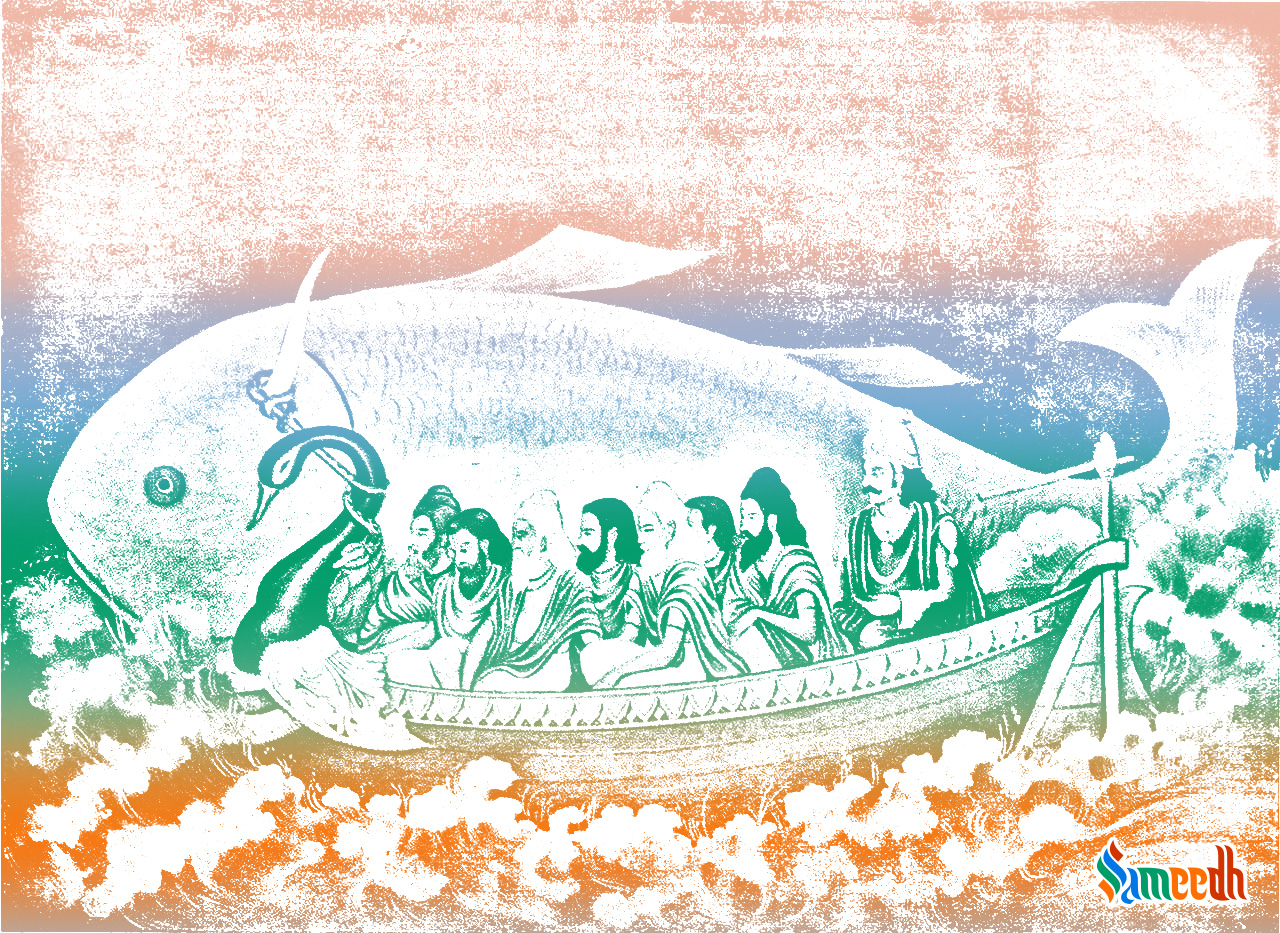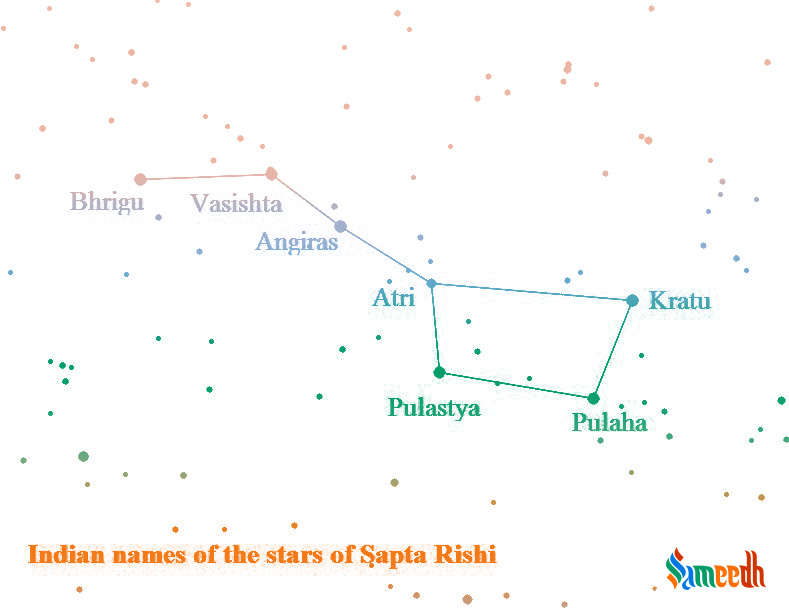‘Sapta’ means seven, and ‘Rishi’ means a sage or seer in Sanskrit hence, Saptarishi literally means ‘seven seers’. Saptarishi are the Brahmarishi or scholars who wrote the scientific Indian scriptures such as Ved, Puran, and Upanishad. They created and updated them from time to time. The legends say, Brahma created a series of scholars as ‘Manas Putra’ to impart wisdom and education to human beings.

The names of the seven Sapta Rishis are typically given as follows:
- Atri
- Bharadwaj
- Gautam
- Jamadagni
- Kashyap
- Vasishth
- Vishvamitr
Each of these sages has its own distinct story, lineage, and contributions to Vedic literature and philosophy.
Timeline of Saptarishi:
We can not point out any particular timeline for these seven seers because they existed as an institution. Different scholars contributed to the intellectual processes at different ‘manvantar’ (ages), and their charisma is remembered beyond generations. New Saptarishi take charge at the change of each Manavantar – the time of Manu.
Different scriptures enlist different combinations for the seven most learned and extraordinary beings of their times – as Saptarishi. That’s why the combination of different names appears in different scriptures such as Ramayan, Mahabharat, Upanishad, Puran, Tamil Scriptures, Jain Scriptures, and Sikh Scriptures.
Saptarishi in different scriptures:
| Western Astronomy | Popular Understanding | Mahabharat | Brihad
Samhita |
Jainism | This Manavantara | Next Manavantara |
| Alkaid | Bhrigu | Marichi | Marichi | Surmanyu | Vishvamitra | Galava |
| Mizar | Vashishth | Vashishth | Vashishth | Shrimanyu | Vashishth | Diptimat |
| Alcor | Arundhati | Arundhati | Arundhati | – | Arundhati | – |
| Alioth | Angiras | Kashyap | Angiras | Shrinichay | Kashyap | Vyas |
| Megrez | Atri | Atri | Atri | Sarvasundar | Atri | Durani/ Ashvatthama |
| Dubhe | Kratu | Kratu | Kratu | Jayvaan | Gautam | Rishyasringa |
| Merak | Pulaha | Pulaha | Pulaha | Vinaylaala | Jamadagni | Kripa |
| Phecda | Pulatsya | Pulatsya | Pulatsya | Jaymitra | Bharadvaj | Parshuram |
The basis of Gotra system:
Saptarishi form the basis of the ‘Gotra’ system in Sanatan Religion for identifying ancestry. Each Gotra represents a clan. It is a paternal lineage system, and the child is accorded the ‘Gotra’ of the father. Usually, marriages amongst the same Gotra are avoided.
Saptarishi – The Ursa Major Constellation:
In astronomy, Saptarishi Mandalam is known as ‘Ursa Major or Big Dipper’. And it appears to be rotating around ‘Dhruva’ or Polaris star. They say ‘Saptarishi Mandalam’ revolves around Dhruva once every 26,000 years. Atharvaveda has a hymn about Saptarishi being veiled by a Dhumaketu (comet) more than 3000 years ago.
The position of Saptarshi in the sky with reference to other constellations – was used extensively to define a historical timeline. The Saptarishi Chara in 13th Adhyay of Brihatsamhita says the following:
आसन् मघासु मुनयः शासति पृथ्वीं युधिष्ठिरे |
षड्द्वीकपञ्चद्वियुतः शककालस्तस्य राज्यश्च ||
It says, “Saptarishi Mandala was in ‘Magha’ Nakshatra after the 2526 year in Shaka Calendar, when Yudhishthir became the king of the earth.”
Saptarishi appears prominently in the Indian sky every year during Phalgun – Chaitra (March) month to Shravan – Bhadrapad (September) month. It is the third brightest constellation in the night sky!

Seven Stars or Eight Stars?
Contrary to popular belief, there are eight stars, not seven stars in the Saptarishi constellation. There is a binary star system in this constellation – made of two stars rotating around each other. In western astronomy, they are known as Alcor and Mizar, while in India, they are called Arundhati and Vashishth.
Saptarishi – Festivals in India:
To pay respect to these seven sages, throughout India and Nepal, the Rishi Panchami/ Sama Pancham festival is observed on the fifth day of Shukla Paksh in the Bhadrapad month. In 2022, Rishi Panchami will be celebrated on 1st September!
Saptarishi – Iconic Places in India:
Saptarishi Kund – A glacial lake in Uttarakhand state – considered to be the source of Yamuna River. It is a very scenic place with stunning mountains and natural beauty.
Saptagiri Hills – The seven peaks in Tirumala representing the seven seers – in Chittoor District, Andhra Pradesh state. On the seventh peak, there is the Tirupati Balaji temple.
Saptarshi Tila – A mound on the banks of Yamuna River, once visited by seven seers, and the place from where numerous ancient idols and artifacts have been found.
Saptarishi Ashram – The place where Saptarishi meditated and calmed down the flow of Ganga River – splitting it into seven streams near Haridwar in Uttarakhand state.
Saptarishi Ghat – A scenic ghat or ‘steps’ on the bank of Pushkar Lake in Ajmer district of Rajasthan state – where several old temples are located and Pushkar festival is held.